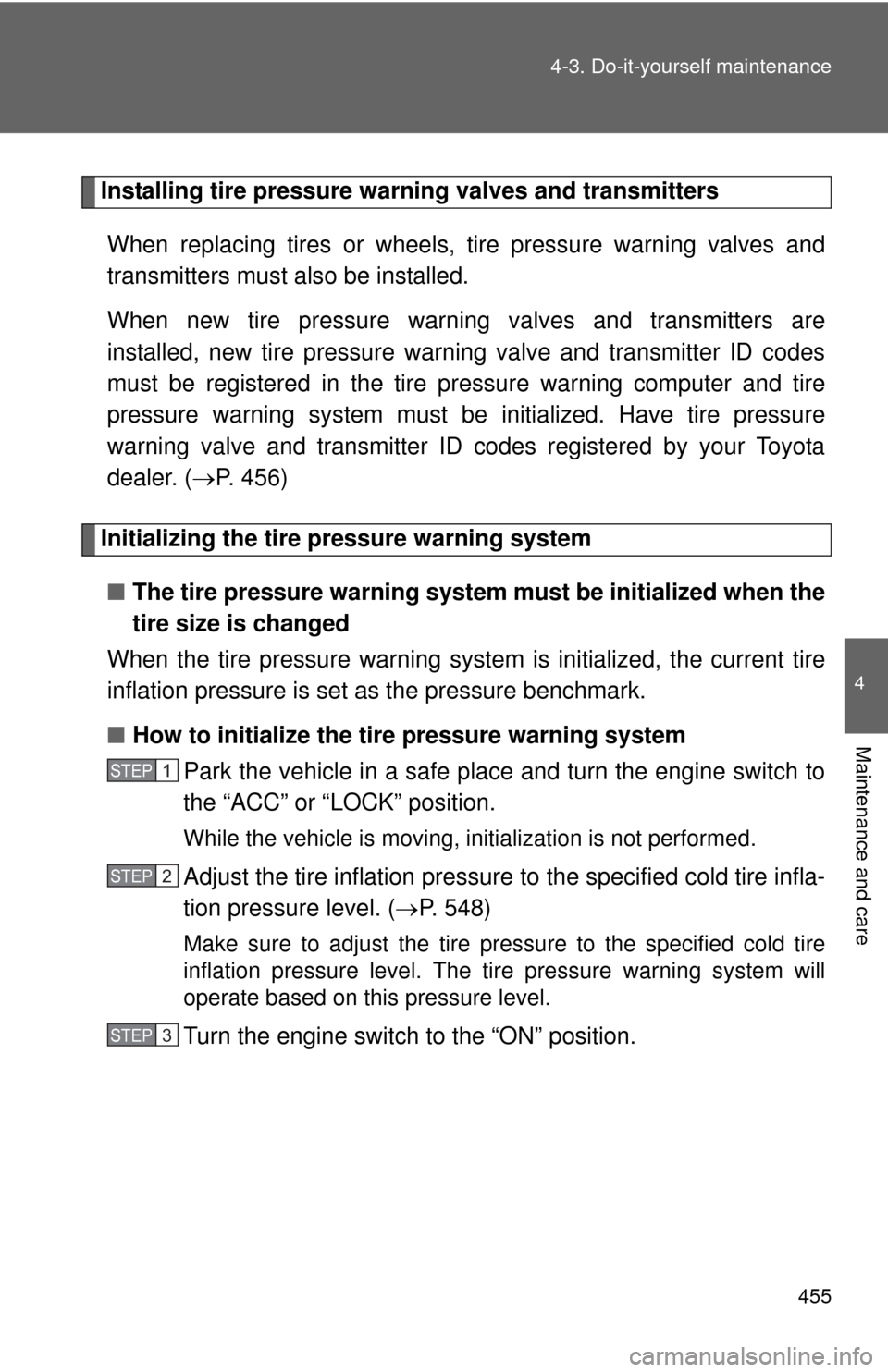Page 455 of 592

455
4-3. Do-it-yourself maintenance
4
Maintenance and care
Installing tire pressure warning valves and transmitters
When replacing tires or wheels, tire pressure warning valves and
transmitters must also be installed.
When new tire pressure warning valves and transmitters are
installed, new tire pressure warning valve and transmitter ID codes
must be registered in the tire pr essure warning computer and tire
pressure warning system must be initialized. Have tire pressure
warning valve and transmitter ID codes registered by your Toyota
dealer. ( P. 456)
Initializing the tire pressure warning system
■ The tire pressure warning system must be initialized when the
tire size is changed
When the tire pressure warning syst em is initialized, the current tire
inflation pressure is set as the pressure benchmark.
■ How to initialize the tire pressure warning system
Park the vehicle in a safe plac e and turn the engine switch to
the “ACC” or “LOCK” position.
While the vehicle is moving, in itialization is not performed.
Adjust the tire inflation pressure to the specified cold tire infla-
tion pressure level. ( P. 548)
Make sure to adjust the tire pressure to the specified cold tire
inflation pressure level. The ti re pressure warning system will
operate based on this pressure level.
Turn the engine switch to the “ON” position.
STEP1
STEP2
STEP3
Page 456 of 592
456 4-3. Do-it-yourself maintenance
Push and hold the tire pressure
warning reset switch until the tire
pressure warning light blinks
slowly three times.
Wait for several minutes with the engine switch in the “ON”
position, and then turn the engine switch to the “ACC” or
“LOCK” position.
Registering ID codes The tire pressure warning valve and transmitter is equipped with a
unique ID code. When replacing a tire pressure warning valve and
transmitter, it is necessary to regi ster the ID code of tire pressure
warning valve and transmitter. Have the ID code registered by your
Toyota dealer.
STEP4
STEP5
Page 469 of 592
469
4-3. Do-it-yourself maintenance
4
Maintenance and care
Air conditioning filter
The air conditioning filter must be cleaned or changed regularly to
maintain air conditioning efficiency.
■ Removal method
Turn the engine switch to the “LOCK” position.
Open the glove box. Slide off
the damper.
Push in each side of the glove
box to disconnect the claws.
Remove the filter case.
STEP1
STEP2
STEP3
STEP4
Page 474 of 592
474
4-3. Do-it-yourself maintenance
Checking and replacing fuses
If any of the electrical components do not operate, a fuse may have
blown. If this happens, check and replace the fuses as necessary.
Turn the engine switch to the “LOCK” position.
The fuses are located in the following places. To check the
fuses, follow the in structions below.
Engine compartment
Push the tab in and lift the lid
off.
Driver’s side instrument panel Remove the lid.STEP1
STEP2
Page 478 of 592
478 4-3. Do-it-yourself maintenance
Fuse layout and amperage ratings■ Engine compartment
FuseAmpereCircuit
1 MAIN 30 A Headlights, daytime running light
system, H-LP RL, H-LP LL
2 AM2 30 A INJ, IGN, GAUGE 2
3 ETCS 10 A Multiport fuel injection system/
sequential multiport fuel injection
system
4 DRL 20 A Daytime running light system,
H-LP RH, H-LP LH
5 DOOR NO.2 25 A Power door lock system
6 HORN 10 A Horns
7 DOME 10 A Personal/interior lights, vanity
lights, door courtesy lights, luggage
compartment light, engine switch
light, trip information display
Page 495 of 592
When trouble arises5
495
5-1. Essential informationIf your vehicle needs to be towed ........................ 496
If you think something is wrong ......................... 500
Fuel pump shut off system ........................... 501
Event data recorder ......... 502 5-2. Steps to take in an
emergency
If a warning light turns on or a warning buzzer
sounds... ....................... 504
If you have a flat tire (vehicles with
run-flat tires)................... 515
If you have a flat tire (vehicles with
standard tires) ................ 516
If the engine will not start ................................ 529
If the shift lever cannot be shifted from P............ 530
If you lose your keys/ wireless remote control
transmitter ...................... 531
If the battery is discharged ..................... 532
If your vehicle overheats ....................... 536
If the vehicle becomes stuck .............................. 539
Page 496 of 592
496
5-1. Essential information
If your vehicle needs to be towed
Before towingThe following may indicate a problem with your transmission. Contact
your Toyota dealer before towing.
● The engine is running, but the vehicle will not move.
● The vehicle makes an abnormal sound.
If towing is necessary, we recommend having your vehicle towed by
your Toyota dealer or a commerci al towing service, using a lift-type
truck or a flat bed truck.
Use a safety chain system for all to wing, and abide by all state/pro-
vincial and local laws.
2WD models only: If towing from th e front, the vehicle's rear wheels
and axles must be in good condition. ( P. 497)
If they are damaged, use a towing dolly or flat bed truck.
Page 500 of 592
500
5-1. Essential information
If you think something is wrong
If you notice any of the following symptoms, your vehicle probably
needs adjustment or repair. Contact your Toyota dealer as soon as
possible.
■ Visible symptoms
●Fluid leaks under the vehicle
(Water dripping from the air cond itioning after use is normal.)
● Flat-looking tires or uneven tire wear
● Engine coolant temperature g auge needle continually points
higher than normal
■ Audible symptoms
●Changes in exhaust sound
● Excessive tire squeal when cornering
● Strange noises related to the suspension system
● Pinging or other noises related to the engine
■ Operational symptoms
●Engine missing, stumbling or running rough
● Appreciable loss of power
● Vehicle pulls heavily to one side when braking
● Vehicle pulls heavily to one side when driving on a level road
● Loss of brake effectiveness, s pongy feeling, pedal almost
touches the floor